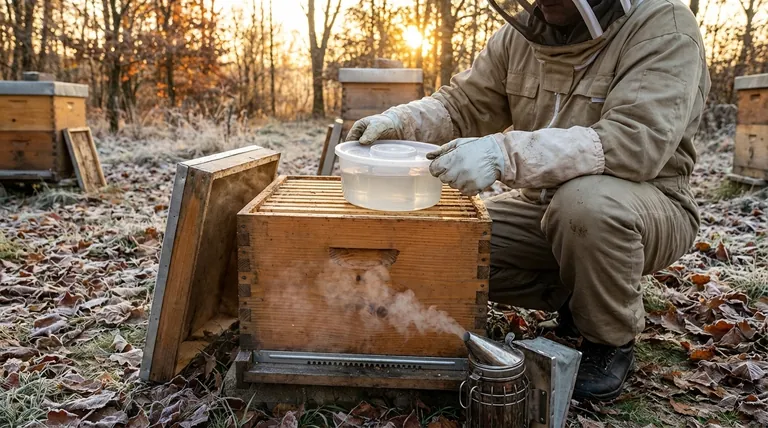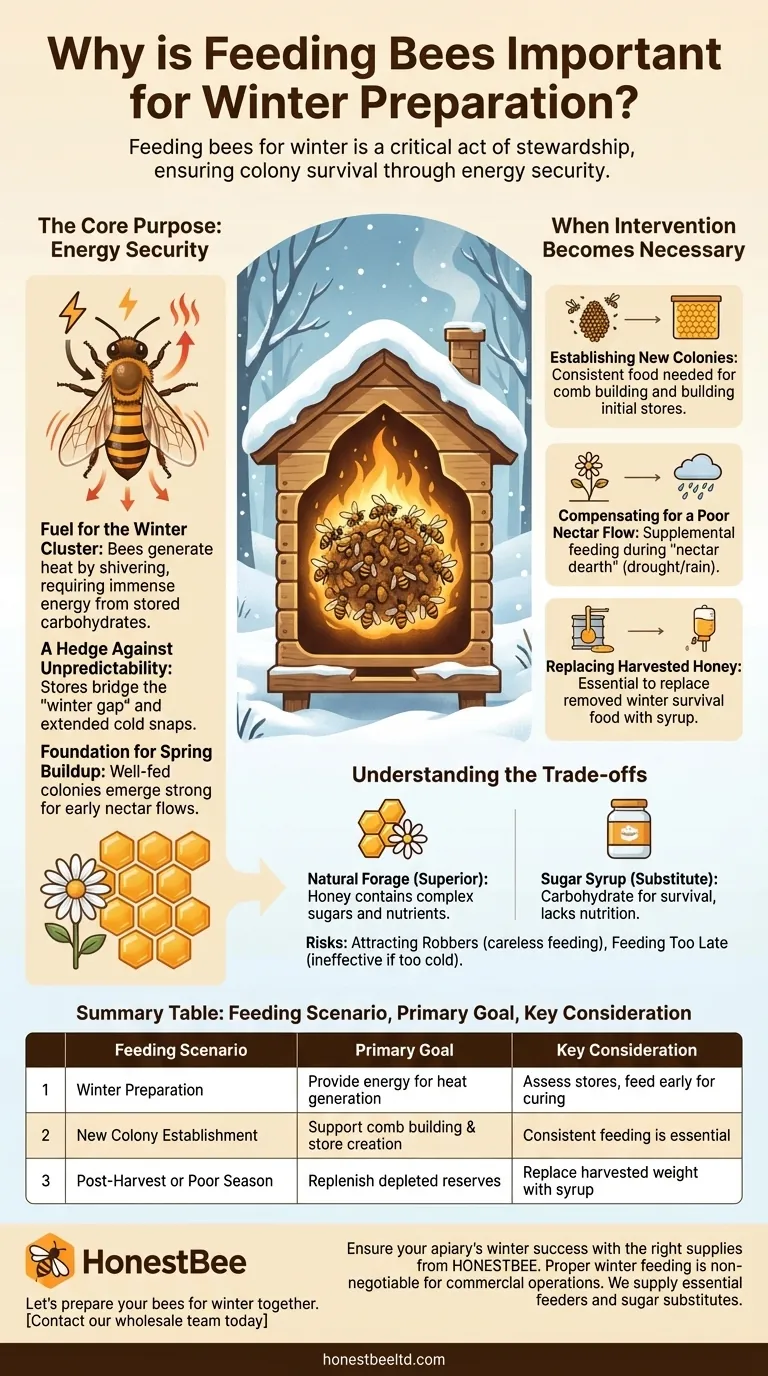Feeding bees for winter is a critical act of stewardship. It ensures the colony has enough stored carbohydrates to generate heat and survive the long, cold months when they cannot forage for nectar. Without sufficient food reserves, the colony will almost certainly starve before the first flowers of spring appear.
A beekeeper's primary role in autumn is to assess a hive's food reserves and supplement them if necessary. This isn't just about preventing starvation; it's about ensuring the colony is strong enough to emerge healthy and productive in the spring.

The Core Purpose of Winter Feeding: Energy Security
A beehive in winter is not dormant; it is in a constant battle against the cold. Feeding is the act of providing the fuel necessary to win that fight.
Fuel for the Winter Cluster
Bees survive the cold by forming a tight cluster around their queen. The bees on the inside of the cluster consume honey and then vibrate their wing muscles, generating heat to keep the core temperature stable. This process requires a tremendous and continuous expenditure of energy.
A Hedge Against Nature's Unpredictability
The period from the last autumn nectar flow to the first spring bloom is the "winter gap." A beekeeper must ensure the hive has enough stores to bridge this entire period, which can be extended by late springs or unseasonable cold snaps.
The Foundation for Spring Buildup
A colony that emerges from winter well-fed can immediately begin raising the next generation of bees. A colony weakened by hunger will be slow to build up, missing out on early nectar flows and potentially struggling for the entire season.
When Beekeeper Intervention Becomes Necessary
While winter is the most common time to think about feeding, a beekeeper must be prepared to intervene whenever a colony's food security is at risk.
Establishing New Colonies
A newly hived swarm or a package of bees starts with nothing. They need a consistent source of food to draw out wax comb, raise young, and build up the stores required to survive their first winter.
Compensating for a Poor Nectar Flow
Drought, excessive rain, or unseasonable weather can create a "nectar dearth" at any point in the season. During these times, even established colonies may need supplemental feeding to prevent them from consuming the stores meant for winter.
Replacing Harvested Honey
If a beekeeper harvests honey, they are removing the colony's winter survival food. It is the beekeeper's absolute responsibility to replace those stores with sufficient sugar syrup to see the colony through winter.
Rescuing a Weakened Hive
A colony may be weak due to disease, pest pressure, or being robbed by other bees. Supplemental feeding can provide the energy needed to recover and rebuild its population.
Understanding the Trade-offs
Feeding is a powerful tool, but it is not without risks and considerations. It is an intervention, and the goal should always be to support the colony's natural processes, not replace them.
Natural Forage is Always Superior
Honey contains complex sugars, enzymes, and micronutrients that sugar syrup lacks. Syrup is a carbohydrate substitute for survival, not a perfect nutritional replacement. A beekeeper's first goal should be to leave the bees enough of their own honey.
The Risk of Attracting Robbers
Feeding, especially if done carelessly, can attract bees from stronger neighboring hives. This can incite a "robbing frenzy" where the stronger colony attacks the weaker one to steal its stores, often destroying the hive in the process.
The Danger of Feeding Too Late
Bees need warm enough temperatures to take the sugar syrup, process it with enzymes, and dehydrate it to the correct moisture content before capping it in the cells. Feeding cold syrup or feeding too late in the autumn is ineffective and can introduce excess moisture into the hive.
Making the Right Choice for Your Colony
Your decision to feed should be based on a direct assessment of your colony's specific situation.
- If your primary focus is a new colony: You will almost certainly need to feed consistently to help them build comb and establish the stores needed for their first winter.
- If your primary focus is an established hive after a poor season: You must assess their stores by lifting the hive or inspecting frames and feed them until they reach their target winter weight.
- If your primary focus is post-harvest preparation: Your responsibility is to replace the weight of the honey you took with an equivalent amount of feed, ensuring the bees are left with more than enough to survive.
Proactive feeding is the beekeeper's most direct tool for ensuring a colony's survival and setting the stage for success in the coming year.
Summary Table:
| Feeding Scenario | Primary Goal | Key Consideration |
|---|---|---|
| Winter Preparation | Provide energy for heat generation in the cluster. | Assess stores and feed early to allow proper curing. |
| New Colony Establishment | Support comb building and initial store creation. | Consistent feeding is essential for foundation. |
| Post-Harvest or Poor Season | Replenish depleted food reserves for survival. | Replace harvested honey weight with sugar syrup. |
Ensure your apiary's winter success with the right supplies from HONESTBEE.
Proper winter feeding is non-negotiable for commercial beekeeping operations and distributors. We supply the essential beekeeping supplies and equipment—including feeders and high-quality sugar substitutes—to help your colonies thrive. A well-fed hive is a productive hive, leading to stronger spring buildup and better honey yields.
Let's prepare your bees for winter together. Contact our wholesale team today to discuss your needs.
Visual Guide

Related Products
- Rapid Bee Feeder White Plastic 2L Round Top Feeder for 8 or 10-Frame Bee Hives
- HONESTBEE Round Hive Top Bee Feeder for Syrup
- HONESTBEE Entrance Bee Feeder Professional Hive Nutrition Solution for Beekeeping
- Classic Boardman Entrance Bee Feeder Hive Front Feeding Solution
- Professional Hive Top Bee Feeder for Beekeeping
People Also Ask
- What is the advice regarding feeding bees to limit brood production based on? Managing Prolific Bee Strains
- What is the capacity of the round hive top feeder for syrup and pollen? A Guide to Targeted Apiary Support
- How do you set up and use a top feeder for bees? A Step-by-Step Guide for Safe Feeding
- Can you dilute honey and feed it to the bees? Understand the Critical Risks and Safe Practices
- What are the recommended sugar-to-water ratios for making sugar syrup for bees? Optimize Your Hive's Health



















